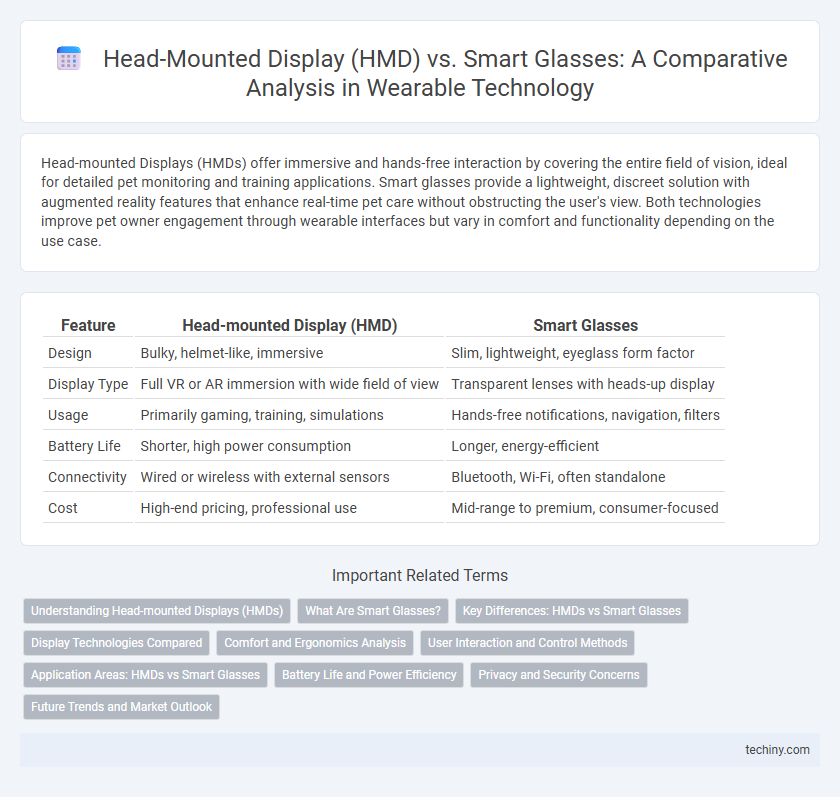Head-mounted Displays (HMDs) offer immersive and hands-free interaction by covering the entire field of vision, ideal for detailed pet monitoring and training applications. Smart glasses provide a lightweight, discreet solution with augmented reality features that enhance real-time pet care without obstructing the user's view. Both technologies improve pet owner engagement through wearable interfaces but vary in comfort and functionality depending on the use case.
Table of Comparison
| Feature | Head-mounted Display (HMD) | Smart Glasses |
|---|---|---|
| Design | Bulky, helmet-like, immersive | Slim, lightweight, eyeglass form factor |
| Display Type | Full VR or AR immersion with wide field of view | Transparent lenses with heads-up display |
| Usage | Primarily gaming, training, simulations | Hands-free notifications, navigation, filters |
| Battery Life | Shorter, high power consumption | Longer, energy-efficient |
| Connectivity | Wired or wireless with external sensors | Bluetooth, Wi-Fi, often standalone |
| Cost | High-end pricing, professional use | Mid-range to premium, consumer-focused |
Understanding Head-mounted Displays (HMDs)
Head-mounted displays (HMDs) provide immersive visual experiences by projecting digital content directly into the user's field of view, often used in virtual reality (VR) and augmented reality (AR) applications. Unlike smart glasses, which offer a more lightweight, transparent display for notifications and basic information, HMDs typically feature enclosed designs with advanced sensors and wide field-of-view optics. Key technological components of HMDs include high-resolution displays, motion tracking systems, and spatial audio, enabling precise interaction in gaming, training, and simulation environments.
What Are Smart Glasses?
Smart glasses are wearable devices equipped with optical displays that project information directly into the user's field of vision, combining augmented reality features with everyday eyewear functionality. Unlike head-mounted displays (HMDs), smart glasses offer a more lightweight, stylish, and socially acceptable form factor designed for continuous use. These devices integrate sensors, cameras, and connectivity options to deliver real-time data, notifications, and hands-free interaction without obstructing normal vision.
Key Differences: HMDs vs Smart Glasses
Head-mounted displays (HMDs) offer immersive experiences by fully covering the user's field of vision with digital content, ideal for virtual reality and complex simulations. Smart glasses provide a more lightweight design with a transparent display overlay, enabling augmented reality applications while maintaining situational awareness. HMDs typically have higher processing power and larger batteries, whereas smart glasses prioritize portability and discreet daily use.
Display Technologies Compared
Head-mounted displays (HMDs) typically use high-resolution OLED or microLED panels, offering immersive visuals with wide fields of view and high refresh rates, ideal for virtual reality applications. Smart glasses often rely on waveguide or projection-based display technologies, providing transparent augmented reality overlays without obstructing the user's natural vision. The display brightness, pixel density, and latency in HMDs generally surpass those of smart glasses, prioritizing immersive experience over continuous environmental awareness.
Comfort and Ergonomics Analysis
Head-mounted displays (HMDs) often provide immersive experiences but tend to be bulkier and heavier, which can cause discomfort during prolonged use compared to smart glasses. Smart glasses prioritize lightweight design and better weight distribution, enhancing user comfort and reducing strain on the neck and temples. Ergonomically, smart glasses offer a more natural fit aligned with daily activities, while HMDs may require additional adjustments to achieve optimal comfort.
User Interaction and Control Methods
Head-mounted displays (HMDs) typically offer immersive experiences through extensive head tracking, gesture recognition, and voice commands, enabling precise and intuitive user interaction in virtual environments. Smart glasses prioritize lightweight design and ease of use with touch-sensitive frames, voice control, and limited gesture inputs, focusing on quick access to information without obstructing the user's field of view. Control methods in HMDs emphasize comprehensive engagement and multi-modal input, while smart glasses optimize for subtle, seamless interaction integrated into daily activities.
Application Areas: HMDs vs Smart Glasses
Head-mounted displays (HMDs) are primarily utilized in immersive applications such as virtual reality (VR) gaming, military training simulations, and medical imaging, offering full visual immersion and enhanced depth perception. Smart glasses are favored in augmented reality (AR) applications including industrial maintenance, navigation, and real-time data visualization, providing users with hands-free access to information while maintaining awareness of the real world. The distinct application areas reflect HMDs' focus on immersive experiences versus smart glasses' emphasis on seamless, context-aware interactions.
Battery Life and Power Efficiency
Head-mounted displays (HMDs) typically consume more power due to advanced features like high-resolution screens and immersive sensors, resulting in shorter battery life compared to smart glasses. Smart glasses prioritize power efficiency by incorporating low-energy displays and limited processing capabilities, enabling extended use throughout the day. Battery capacity averages around 2000-3000mAh for HMDs, whereas smart glasses often range between 300-1000mAh, reflecting their differing energy demands and usage scenarios.
Privacy and Security Concerns
Head-mounted displays (HMDs) and smart glasses raise significant privacy and security concerns due to their continuous data collection and real-time environmental monitoring capabilities. HMDs often process and store extensive sensory data, increasing risks of unauthorized access and potential misuse of personal information. Smart glasses, with their discreet recording and location tracking functionalities, present challenges in preventing covert surveillance and protecting user data from cyber threats.
Future Trends and Market Outlook
Head-mounted displays (HMDs) and smart glasses are poised for significant growth, driven by advances in augmented reality (AR) and virtual reality (VR) technologies. Market analysis forecasts a compound annual growth rate (CAGR) of over 25% for wearable AR devices, with smart glasses gaining traction for enterprise and consumer use due to their lightweight design and enhanced connectivity. Future trends highlight integration with AI-driven features, improved battery life, and seamless 5G compatibility, positioning these devices as central components in the evolving wearable technology landscape.
Head-mounted Display (HMD) vs Smart Glasses Infographic

 techiny.com
techiny.com